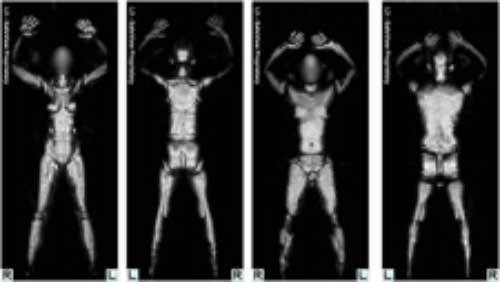Lawsuit Filed Over Airport Scanner Privacy, Health Concerns

A public interest group has filed a lawsuit against the federal government demanding the suspension of the full-body scanners increasingly being used in airports nationwide.
The Electronic Privacy Information Center (EPIC) in Washington, D.C., which filed the lawsuit last month against the Department of Homeland Security's (DHS) Transportation Security Administration (TSA) division, is aiming to suspend both backscatter and active millimeter wave technology until concerns about their privacy protection, health effects, religious freedom ramifications and effectiveness are addressed.
Backscatter technology emits low-dose X-ray radiation to take images that help detect weapons and explosives hidden under clothing, while active millimeter wave technology emits radio waves that can be used to scan a person's body.
“Our goal is to suspend the use of full-body scanners in airports as soon possible,” EPIC staff counsel Ginger McCall told TechNewsDaily. “Not only are these technologies an invasion of privacy, who is there to calibrate them and make sure they are only given the correct amount of radiation?"
Some believe the accuracy of these systems is also debatable, considering images cannot detect explosives hidden in body cavities.
“Since these technologies may not be effective in detecting all threats, it’s critical that we stop the use of them to ensure the health of passengers and protect their privacy,” McCall said. “TSA needs to remove them immediately and return to the traditional form of airport security until safer and more private technology is in place.”
DHS recently announced plans to introduce more of these backscatter advanced imaging technology (AIT) units to airports. The American Recovery and Reinvestment Act (ARRA) – which provided the funds to purchase the units – was signed into law by President Obama in 2009.
Get the world’s most fascinating discoveries delivered straight to your inbox.
With over 150 full-body scanners currently installed in over 40 airports nationwide, the TSA aims to bring that number up to 500 by the end of the year. It has plans to deploy another 500 units – which is priced between $130,000 - $170,000 each – by the end of next year.
How it works
There are currently two forms of technologies currently being used for airport security screenings. Active millimeter wave systems can penetrate clothing to reveal hidden threats, but are not thought to emit harmful radiation.
Backscatter technology, however, requires a passenger to stand in between two box panels as low-dose radiation is emitted to the body, mainly to the scalp, during its scan. The image is then sent to an agent in another room to protect the passenger’s privacy by ensuring the anonymity of the image. If a screening agent sees a threat, they can call another agent over to further inspect the image.
"The TSA has not, will not, and the machines cannot store images of passengers at airports," said TSA spokesperson Sari Koshetz. "The equipment sent by the manufacturer to airports cannot store, transmit, or print, and operators at airports do not have the capability to activate any such function."
These functions are enabled during testing in TSA labs, but are disabled before the machines are sent to airports, Koshetz added.
CNET recently reported that the U.S. Marshal Service — a division of the Department of Justice — had stored thousands of images from a full body scanner in a Florida courthouse, but Koshetz emphasized that this practice does not extend to the TSA.
"The images that are used by the U.S. Marshal Service are very different from ours," she said in a telephone interview. "It's a different technology, [from] a different vendor."
Boston’s Logan International Airport was one of the first 11 airports to receive the backscatter systems as part of an effort to better identify terrorist threats.
Advanced imaging technology is optional for all passengers. All travelers can request alternative screening procedures at the checkpoint.
“Passengers that wish to not receive image technology screening will receive equivalent screening, including metal detection and a physical pat down,” Lee Kair, assistant administrator for security operations for TSA, said during a press conference held at Logan Airport in March.
Health concerns
The TSA has assured the public that full-body scanners are safe for use and meets national and safety standards.
"Backscatter technology was evaluated by independent third parties,” Kair said. “Studies have shown that a single scan with backscatter imaging technology is equivalent to two minutes of airplane flight altitude.”
However, EPIC's McCall said that research disputes these claims. “The TSA likes to say it’s only equivalent to two minutes in the air, but scientists believe it’s much more," she said. The average radiation measurement quoted by the TSA for each scan is about .15 uSv (a unit of radiation).
According to David Brenner of Columbia University, who discussed the topic at the Congressional Biomedical Research Caucus after the TSA began rolling out backscatter technology in airports, the dosage released through it is indeed small, but “not as small as TSA would have us think.”
“The number given is what the whole body receives on average. However, the whole body isn’t actually receiving the radiation exposure. The skin on the scalp receives 20 times the average dose that is typically quoted by TSA and throughout the industry. It’s still a low-dose, but it’s much more than what’s usually said.”
Radiation acts as a multiplier of natural cancer rates, Brenner said. There are 800,000 cases of basal cell carcinoma diagnosed in the United States each year, which is one of the most common cancers associated with X-ray exposure.
“The concern is that radiation promotes pre-existing damage,” he said. “Since the cancer rate is so high for basal cell carcinoma, this number could be multiplied further by radiation risks.” Most of the radiation from X-ray backscatter machines hits the top of the head – where 85 percent of this type of cancer forms.
“There is no good reason why [TSA] scans the head and neck, especially since you can’t hide explosives there,” Brenner said.
“The individual risks associated with X-ray backscatter scanners are probably extremely small, but if all 800 million airport annual users are screened via X-ray, then the risk rate is multiplied by a large number – and that implies a potential public health and societal risk,” he added.
Privacy
The EPIC lawsuit states that the program run by the DHS violates the Privacy Act and the Administrative Procedure Act. It also alleges that the systems violate the Religious Freedom Restoration Act, referencing religious laws about modesty.
“It violates modesty for many religions,” McCall said. “We’ve seen Catholics, Orthodox Jews and Muslims all upset by the invasive scanning technologies. It’s a violation of their religious freedom.”
TSA's Koshetz said the agency goes to great lengths to ensure the anonymity of airline passengers and that the machine images are "more humanoid than human," with the millimeter wave and backscatter scanners producing images resembling a "blurred photographic black and white negative" and a "chalk etching," respectively.
Modesty issues aside, EPIC also states that the scanning procedures are a violation of The Fourth Amendment, which guards against unreasonable searches, as travelers undergo a search without any suspicion of wrongdoing.
A safe alternative
Some companies, such as Millivision, are currently developing privacy-protecting, passive millimeter wave technology that uses no radiation.
As a person walks through Millivision’s system, the screener sees an image of the passenger fully clothed. The potential threats, such as a weapon, are highlighted in red.
“The technology is not only safe from radiation, it also ensures that the intimate details of a passenger’s body are not exposed,” said Millivision president Paul Nicholas.
The passive millimeter wave scanners have already been tested and implemented by the Federal Courthouse in Washington D.C. and a few other places.
“We plan to bring our technology to the TSA for testing in this country and then to others in the near future,” Nicholas said.
“There needs to be a safe and private scanning system that accomplishes security screening that is not invasive. We hope the TSA recognizes passive millimeter wave systems as a powerful next-generation solution."



